Big Disclaimer: I’m gonna put this here first because it is very important that this post not be the only lesson in fertility awareness you take (seems obvious but I have to say it). You should absolutely get educated on this method before using it as your only form of birth control. I share resources below.
Women write me and comment on my blog posts ALL the time about how much pain and trouble their hormonal birth control is causing them but they are so terrified of coming off that they just continue to endure the discomfort. It’s nuts.
But I get it – because I’ve soooo been there. I remember it like it was yesterday – taking my very last birth control pill and throwing away the remaining pills. Such a mix of liberation, excitement and um, terror.
I knew in every cell of my being that I needed to get this stuff out of my system. When I first went on it at 19 I was convinced I’d hit the jackpot. A magic cure for my super painful, heavy and irregular periods? Sign me up!
In fact, what I’d really found was the perfect camouflage for my symptoms. In four short years I was riddled with joint pain, I had the worst case of chronic yeast and urinary tract infections, my period had dwindled to one day, I’d forgotten what sex was, my hair was falling out and my digestion was an utter disaster.
Not sexy.
So after countless doctor’s visits and zero answers, I took back control and got the hell off the pill. At first I had no idea what I was doing. My period didn’t come back for a couple of months so I had some time to figure it out.
At the time there were no fancy cell phones or period tracking apps so I just put my period dates into my calendar (on my wall, haha!). How far we’ve come.
When I got my first iphone in 2008 I started tracking the days I got my period on iPeriod, one of the very first apps on the period tracking scene. Then I started tracking signs and symptoms and then eventually I started taking my basal temperature. So it was a very gradual process and at times kinda scary because I didn’t know what I was doing.
So here’s the deal. I am going to share with you the basics on how to use the fertility awareness method and what has worked for me.
If you need guidance around coming off hormonal birth control, I’ve created the ultimate step by step protocol to help you transition off hormonal birth control (the pill, patch, IUD, implant etc) and take back control of your hormones, your body, and your life. I invite you to check out my Fix Your Birth Control Protocol here.
How The Fertility Awareness Method Works
The fertility awareness method is a sympto-thermal method meaning that you will be paying attention to three main proven signs of fertility each month:
1. Your cervical fluid – how it changes throughout the month
2. Your basal body temperature – this is your temperature upon awakening
3. Your cervical position – this also changes throughout the month but some women are not interested in feeling around for their cervix which I completely understand.
The method is based on this premise:
That estrogen, which is dominant in the first half of your cycle (the follicular phase), keeps your basal temperature low and increases your cervical fluid production. And that progesterone, which is dominant in the second half of your cycle (the luteal phase) raises your basal temperature and decreases your cervical fluid production.
There’s more to it than this, but that is basically what happens. Easy so far right?

The Basics on How The Fertility Awareness Method Works
Disclaimer: I’m going to reiterate my earlier disclaimer and say this information is only for you to understand the FAM method, and not for you to start practicing it. See below for additional learning.
#1. Get yourself a cycle tracking app or use a paper chart.
There are a million period-tracking, fertility-charting apps out there! I even wrote a post on the ones I love the most. I’ve tried a lot! LOL Some of my faves are Clue, Groove and Read Your Body, but there are many more and you should totally find what works for you. Also take a look at this article for more on my favorite wearable devices.
Paper charting is the OG of FAM, and there are lots of women who still love to chart their cycles this way. Do what feels best for you. I suggest checking out Lisa Hendrickson Jack’s Fertility Awareness Mastery Charting Workbook or Honoring Our Cycles Natural Family Planning Workbook by Katie Singer.
If you’re new to all of this and feeling freaked out, then I recommend you check out the Daysy Fertility Monitor. Daysy does a lot of the hard work for you, and will tell you whether you are fertile or infertile through a red or green light based on a combination of your basal body temperature and its algorithm. Check out my post on the Daysy and my sweet discount!
#2. Start tracking on day 1 of your cycle.
This is the same day that you start your period. If you are at a different point in your cycle, that’s fine, just mark the days you had your period so the app knows when the first day of your cycle was.
If you have just gotten off the pill and you are having a hormonal bleed (aka a “withdrawal bleed”) then you would do what I said above – mark the first day of your bleed as the first day of your period. This will help you gauge what your cycles will look like once your body is no longer being manipulated by synthetic hormones.
#3. Become a cervical fluid investigator.
You’re probably like, what does this even mean? I know I get it, I used to think I had a yeast infection every month when my cervical fluid would change, so I was pretty clueless when I first started doing this too.
Start by checking out your undies every day. Is there anything there? What does it look like and feel like? Sticky, creamy, slippery, stretchy, watery, clear, opaque? What color is it? White, slightly yellowish, another color?
After your period you might have no cervical fluid or feel “dry” down there. Please keep in mind that our vaginas are never really dry, there is always going to be some moisture. One of the ways to tell is if you wipe after going to the bathroom and your vulva feels “dry”.
As you approach ovulation which typically happens between days 12-21 in regular 25-35 day cycles, you’ll find that your cervical fluid takes on a wetter consistency. Usually it starts out creamy and then turns to watery, eggwhite-like, slippery, clear or slightly cloudy, and stretchy. You might even feel a gush around ovulation time. Make notes on all of this.
It might seem time-consuming at first but seriously, collecting all this data on your body (aka biohacking), is probably one of the best things you could ever do for your present and future health.
Note: If your cycle is irregular (shorter than 25 days or longer than 35 days), then your ovulation might happen earlier or later than that 12-21 day window. This is important information and should be noted as well.
#4. Take your basal temperature.
A basal body temperature is a person’s temperature first thing upon awakening. Before ovulation, your waking temperatures tend to be low, anywhere from 97.0 – 97.7. A day or two after ovulation, they will typically rise at least two tenths (2/10’s) of a degree and stay elevated until your next period. Post-ovulatory temperatures usually rise to 97.8 degrees or higher. This is caused by the production of the heat-inducing hormone, progesterone.
You want to start by taking your BBT first thing each morning before getting out of bed or doing anything else. This will give you the most accurate reading. Also, make sure you take your temp after at least three consecutive hours of sleep.
Record the temperature in your app or on your paper chart.
Keep in mind that stress, illness, air travel and lack of sleep can have an effect on your temps.
You will typically start to see a pattern within a couple of cycles of consistent charting, although it could take longer depending on whether you’ve got an underlying hormonal imbalance. See example charts below…
#5. Follow the FIVE rules of charting.
This is a little in-depth and requires some practice. You can learn the details of the FIVE rules and get a clearer understanding in my Fix Your Birth Control Protocol here.
Here’s an example of a healthy menstrual cycle with temperatures only (no cervical fluid) and basic rules of charting. Keep in mind that yours doesn’t have to look exactly like this to be healthy. 🙂
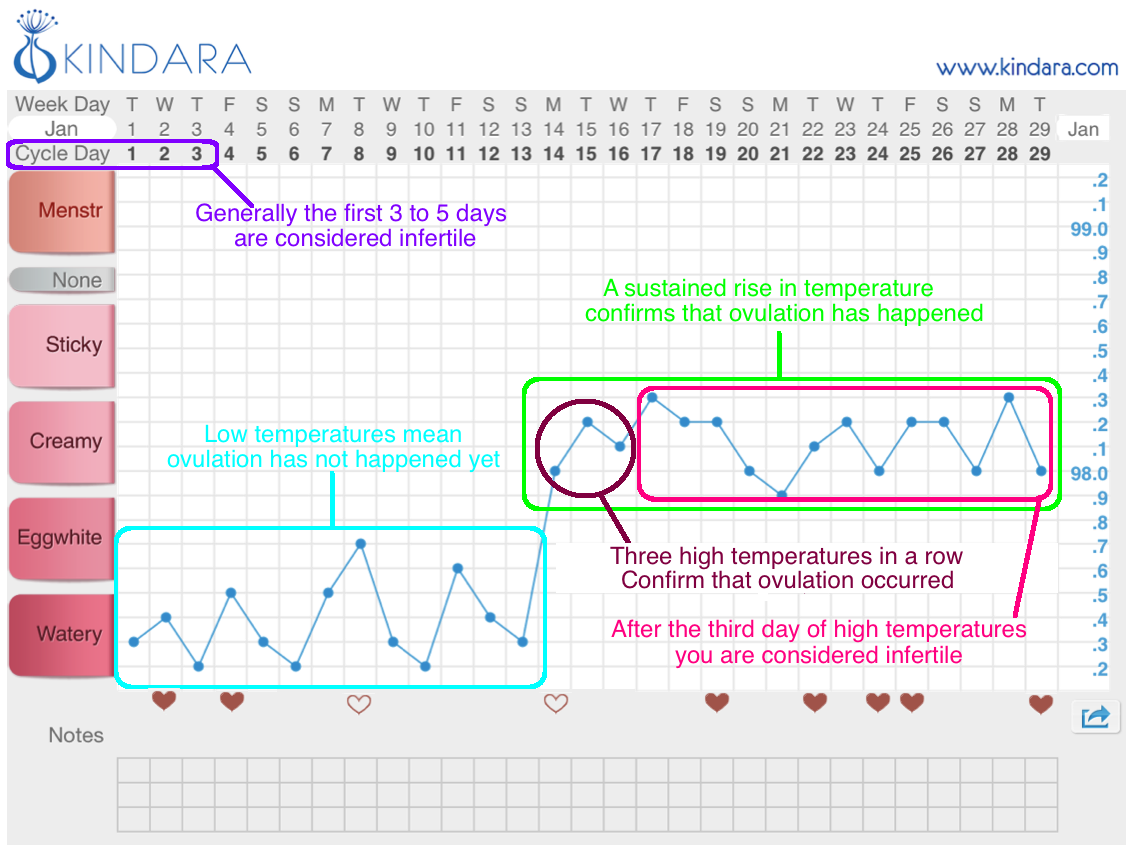
If you have PCOS you might see many consistently low temps (1), false peaks where your cervical fluid becomes more fertile but there is no ovulation (2,3) and a delayed temp rise (4). This is because your body can attempt to ovulate multiple times in one cycle, so you’ll see a potential an increase in fertile quality cervical fluid when it is attempting to do that. See below:
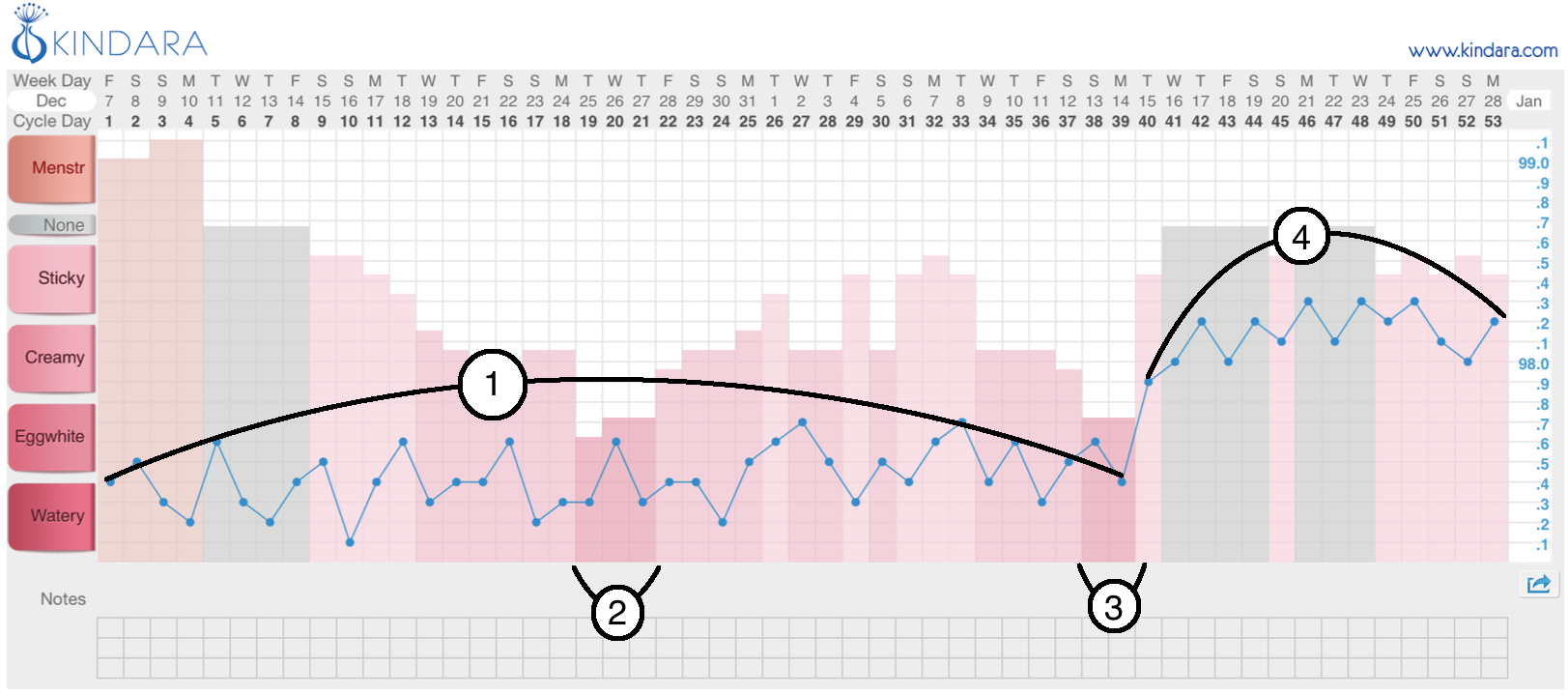
If you have anovulatory cycles you will likely observe long periods of low temps (1) without fertile cervical fluid and no ovulation (2).
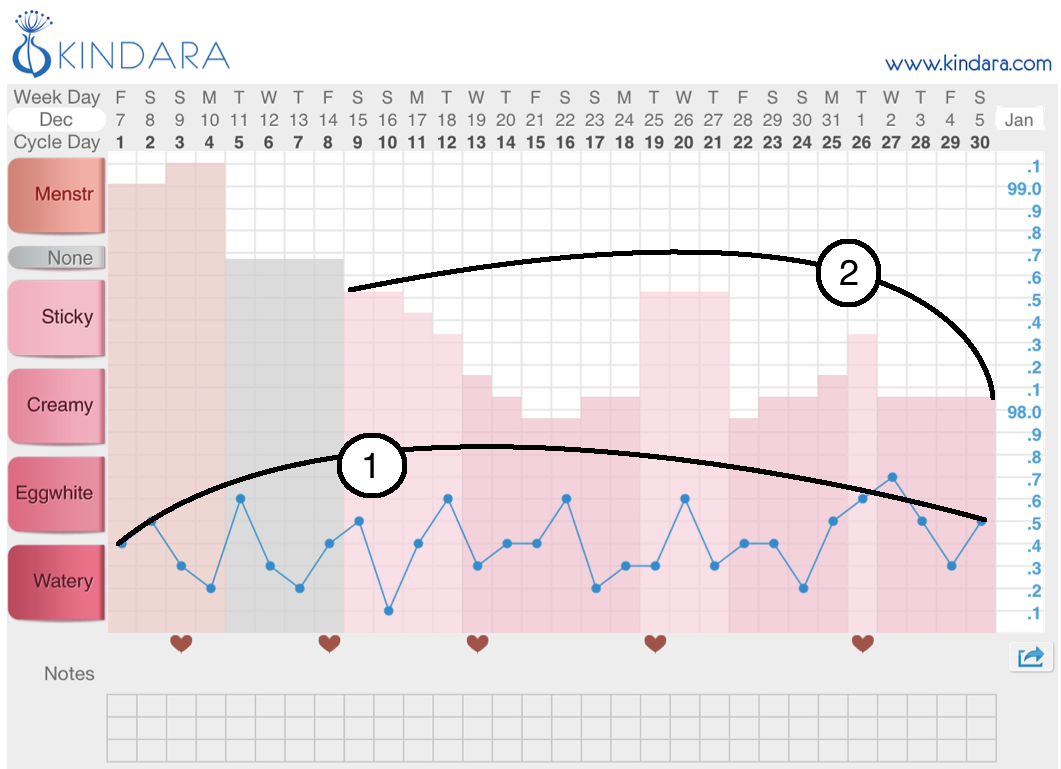
Okay, those are the basics on how the Fertility Awareness Method works. Like I said above, it’s extremely important that you learn this method before using it as a form of birth control. The goal should be to develop a basic understanding of it and start tracking your menstrual cycle using the suggestions above, and get proper training as a next step.
Next steps:
- If you have come off of hormonal birth control, I suggest my Fix Your Birth Control Protocol for the exact steps to get off hormonal contraceptives safely. It includes my Post-Pill Strategy with diet, supplement/herbal remedies and lifestyle recommendations for the first six months after you come off birth control, along with an introduction to cycle charting and natural birth control solutions.
- Find a trained Fertility Awareness Method Practitioner to teach you how to practice this method of birth control safely. I suggest checking out Lisa Hendrickson (fertilityfriday.com), Katie (naturalbirthcontrol.com) and Hannah Ransom (holistichormonalhealth.com).
- Check out these books Taking Charge of Your Fertility, The Fifth Vital Sign, The Garden of Fertility.
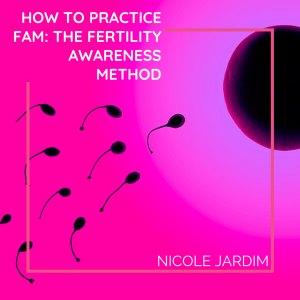
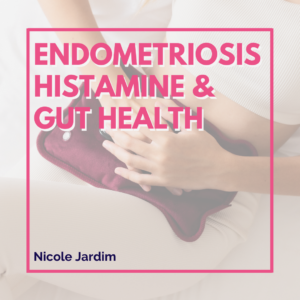

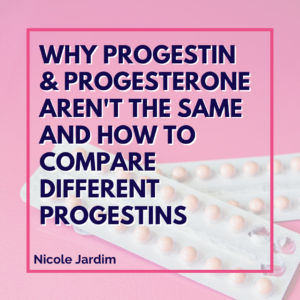
24 thoughts on “How To Practice FAM: The Fertility Awareness Method”
Pingback: The Best Time In Your Cycle to Test Progesterone - Nicole Jardim
Pingback: Can the copper IUD harm your health & fertility? - Nicole Jardim
Pingback: Low Progesterone: Why it happens and what you can do about it - Nicole Jardim
And thank you, Nicole!!! Your content is so scientific and so persuasive!!! My daughter is super smart and well on her way to being valedictorian of her high school senior class next year. She really, really wanted to go on the pill at first and insisted on seeing all the science herself before she would agree to use Daysy instead. When I first told her I wanted her to use FAM she threw a fit and told me I was crazy. She works so hard in high school and is terrified of getting pregnant. Your content won her over, though, and now she trusts Daysy completely because of you!!! I never could have persuaded her to make the healthy choice to use FAM and Daysy without your website.
I would like to use the Daysy for birth control but need to be sure it is really reliable since I am still in high school and can’t get pregnant. Is the Daysy better than an IUD?
Hi nicole
The information should be known to all of us that natural birth control can be done. But I think it may be risky if men or woman do not use some of the modern birth control methods. so What do you think nicole which one is best natural way or technological way?
I’m wondering if there’s other safe alternatives of birth control for teenagers?
Nicole recommends Daysy, a personal fertility tracker, as a safe alternative to hormonal birth control for women of any age. You can read about it in detail in this blog post. Of course, condoms are always a safe alternative to hormonal birth control for sexually active teenagers.
Nicole:
I showed my 16 year old daughter your very informative content to persuade her to use Daysy instead of going on the pill. At first she was really nervous about having sex without a condom, but now she is much more relaxed and in tune with her body, and I am glad to know she is not poisoning her body with hormones.
Wendy, I am thrilled your daughter is using Daysy. I just wanted to make sure that she is using condoms during her fertile window and is also using them in general for protection from STDs and STIs. Certainly using the Daysy and FAM method are valuable systems to learn and know about, but I think it’s important that I mention this to you just to be on the safe side.
No, she and her boyfriend don’t use condoms now that she has Daysy. I explained outercourse to her, and they just don’t go all the way with full P-in-V sex on her red days.
Wendy:
I am almost your daughter’s same age and use a period tracker on my phone to know my safe days. I would get in big trouble with my mom if she found condoms in my room! The hard part is skipping sex around ovulating because it’s all I can think about on those days, and my boyfriend is even worse. Do you know what your daughter does those days?
Joella, you sound like a very responsible young woman. It is too bad you cannot discuss being sexually active with your mom. It is perfectly normal to experience a heightened sex drive around ovulation. That is just how Mother Nature works for many of us. : ) What I do, and what I taught my daughter to do, is to use genital-on-genital frottage on your fertile days. That means you spread your labia (your two sets of lips) apart so that he can slide his penis in between and work up and down from the perineum (where your vagina ends) up your clitoris. It feels really good! Just make sure you use lots of lubricant to make everything really slippery; baby oil is great if you are not using condoms (which is of course would just come off anyway when he’s rubbing against you). I recommend the missionary position (you on your back, with you boyfriend on top and between your legs) .
Obviously, unless your boyfriend has a lot of self control, you should avoid letting him penetrate you without a condom, and make sure you have a tissue nearby to clean up after he ejaculates. Good luck!
To share some feedback from my daughter — she says that she is really happy they decided they shouldn’t rely on condoms on her Daysy “red” days because that means her boyfriend knows he can’t “go all the way” with P-in-V those days and that being careful on her fertile days builds trust and intimacy. I think that shows a lot of maturity for a 16 year old that probably would not have happened without Daysy.
Thanks so much for sharing that your daughter has figured out what works for her. 🙂
And thank you, Nicole!!! Your content is so scientific and so persuasive!!! My daughter is super smart and well on her way to being valedictorian of her high school senior class next year. She really, really wanted to go on the pill at first and insisted on seeing all the science herself before she would agree to use Daysy instead. When I first told her I wanted her to use FAM she threw a fit and told me I was crazy. She works so hard in high school and is terrified of getting pregnant. Your content won her over, though, and now she trusts Daysy completely because of you!!! I never could have persuaded her to make the healthy choice to use FAM and Daysy without your website.
Hi Nicole,
How do I go about this natural method right after having a baby.???
I’m in the 6th week of postpartum, and breastfeeding and pumping. I don’t want to go back to the pill or any prescribed method and the thought of surgery was just scary to me. This was baby number three and we have both agreed to no more babies. Ummmm..that’s what we said last time, but of course I ran out of the pill, had many changes in our life all at once and baby happened. ,?.
Also I was diagnosed with PCOS 10 years ago. Not sure how accurate it was but I do have certain symptoms in relation, excess weight gain or loss, hirsutism, insulin resistance… Etc.
Please your input. Thanks
Hi. The best resource for learning NFP (natural family planning) is The Couple to Couple League. http://www.ccli.org. They teach you the sympto-thermal method. You can take classes or do a home study course. They also have an app. My hubby and I taught classes for ten years. Also you had the follicular phase and the luteal phase mixed up in the text but it was correct in the chart picture.
Hi Amy, good catch! Thanks for pointing that out…made the change and it should be all good. And thank you for sharing a NFP resource. 🙂
I have the Daysy fertility monitor (same algorithm as in the Lady-Comp but with sleeker design and you can synchronize it with your phone to see charts etc.) to measure my BBT. I wonder how safe are these types of computers as birth control used alone on green days? What can I do to make it safer without too much effort?
Hey CB,
I got a daysy too and it’s amazing! I can’t sing it’s praises enough.
I’ve read up on all the science and they have some studies and certificates on their site, but it was a bit hard to find. I had to write to them and they send me some of the links. I’m sure after some careful digging around the site (https://www.usa.daysy.me/) you’ll be able to find a lot of this info
Hey CB, the Daysy is very accurate as a stand alone form of birth control. The way to make it even more accurate is to start charting your cervical fluid and paying attention to when it becomes wetter, stretchier and more fertile, and then when it becomes sticky and dries up.
What do you think of the paragard / copper iud? That’s what I have.
HI Diane, I wrote a post on the Paragard here: https://nicolejardim.com/copperiud/